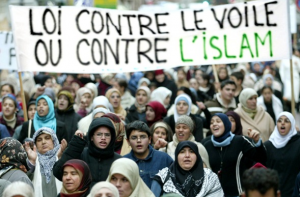 France’s law banning the wearing of hijabs, or headscarves, by Muslim girls and women in public schools went into effect in 2004 among much criticism and controversy. While France’s ban technically outlaws the wearing of any overt religious symbol in a public school (such as large crosses or a kippa), in practice critics say such laws violate a woman’s civil as well as religious rights.
France’s law banning the wearing of hijabs, or headscarves, by Muslim girls and women in public schools went into effect in 2004 among much criticism and controversy. While France’s ban technically outlaws the wearing of any overt religious symbol in a public school (such as large crosses or a kippa), in practice critics say such laws violate a woman’s civil as well as religious rights.
History of the hijab
Hijab generally is taken to mean the head covering worn by some Muslim women, although traditionally the word refers to the Muslim practice of modesty in dress as a whole.
In modern practice it usually takes the form of a scarf or veil covering the head and neck. Some Muslim scholars believe that the Qur’an specifically instructs women to cover their heads in public. Others interpret the relevant passages more liberally to mean all Muslims, men and women, should dress modestly. Other arguments against compulsory head-covering include the fact that it is primarily a cultural and historical, not religious, tradition; women in the Arab world covered their heads as a class or status symbol long before Islam.
In some countries, such as Iran and Saudi Arabia, hijab is law; Muslim women are required to cover their heads in public. At the other extreme, some countries have banned the hijab in certain situations or institutions, as with France’s prohibition against wearing it in public schools. Whether such laws are justified or not is for the courts to decide.
Albania
Albania has introduced draft legislation to ban the hijab in public schools. Similar to French law, the legislation bans the wearing of any overt religious symbols in public elementary and high schools.
Belgium
Belgium’s parliament has passed a bill that would outlaw the wearing, in public areas and buildings, of any clothing that obscures identity by covering the face. This would include burqas and the niqab (a veil that leaves only a woman’s eyes uncovered), although headscarves would be allowed as long as the face is not veiled.
France
A law banning full-face veils in all public places went into effect in France this week, following on several years of controversy and debate. In 2004 hijabs and other “conspicuous” religious symbols were banned in public schools, including turbans and kippas, as an application of the principle of separation of church and state.
Germany
There is no nationwide restriction on religious dress in Germany, but half of the country’s sixteen states have bans or restrictions in place on head coverings in public schools. The city of Berlin has banned all religious symbols and clothing in public institutions, including the hijab.
Syria
Syria has banned the wearing of full face veils, such as the niqab, at public universities. It does allow headscarves that reveal the face.
Tunisia
In 1981, hijabs were banned in schools and government buildings in Tunisia. In 2006, a vigilant crackdown began; police started stopping women wearing the head coverings on the street, asking them to remove the scarves and sign pledges they would no longer wear them.
Turkey
The hijab is banned in Turkey in all public buildings, including universities, schools, libraries, and government buildings. In 2008, Turkey’s top court upheld a ban on wearing Muslim headscarves at the country’s universities. Since the ban was put in place in 1980, thousands of women have been arrested or fined for refusing to take off the hijab or protesting against the ban.




